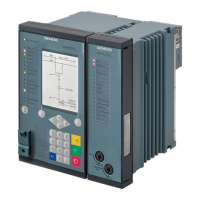The communication ring has the advantage over the communication chain that the entire communications
system and, for example, the differential protection function also work if one of the communication connec-
tions fails or if a device in the topology is taken out of operation.
You can find more information in chapter 3.5.2.5 Device-Combination Settings.
The devices detect failure or logging off, and switch over automatically to the remaining communication
routes.
The following figure shows, for example, a four-line-end differential-protection application if all protection
communications are of type 1. A typical application with protection communications of type 2 is the exchange
of indications and measured values between 4 devices (for example, between switchgears), whereby the
connection can occur via different communication routes. This is the application for a protection-data trans-
mission device.
[dwringto-030211-01.tif, 1, en_US]
Figure 3-43 4 SIPROTEC Devices in a Ring Topology
NOTE
If a connection fails in the ring topology, this configuration continues to function as a chain topology. In
addition, a device in the constellation can be logged off from the topology.
Protection-Interface Information Transfer
With the protection-interface information transfer, customer-specific indications and measured values can be
communicated via the protection interface with settable update cycles (priorities).
There are 3 different priorities when transferring protection-interface information:
•
Priority 1: Use Priority 1 for the transmission of fast protection signals that are transferred and updated
at a maximum of every 20 ms in a telegram.
•
Priority 2: Use Priority 2 for the transmission of fast single-point or double-point indications that are
transferred and updated at a maximum of every 40 ms.
•
Priority 3: Use Priority 3 for all indications, measured, and metered values that are transferred and
updated a maximum of every 100 ms.
The number of customer-specific signals, indications, and measured values conform with the remaining band-
width. The remaining bandwidth is lower than with all other protection functions (type 2) when using a differ-
ential protection (type 1). Customer-specific measured values consume more bandwidth than single-point
indications.
System Functions
3.5 Protection Communication
SIPROTEC 5, High-Voltage Bay Controller, Manual 101
C53000-G5040-C015-9, Edition 11.2017

